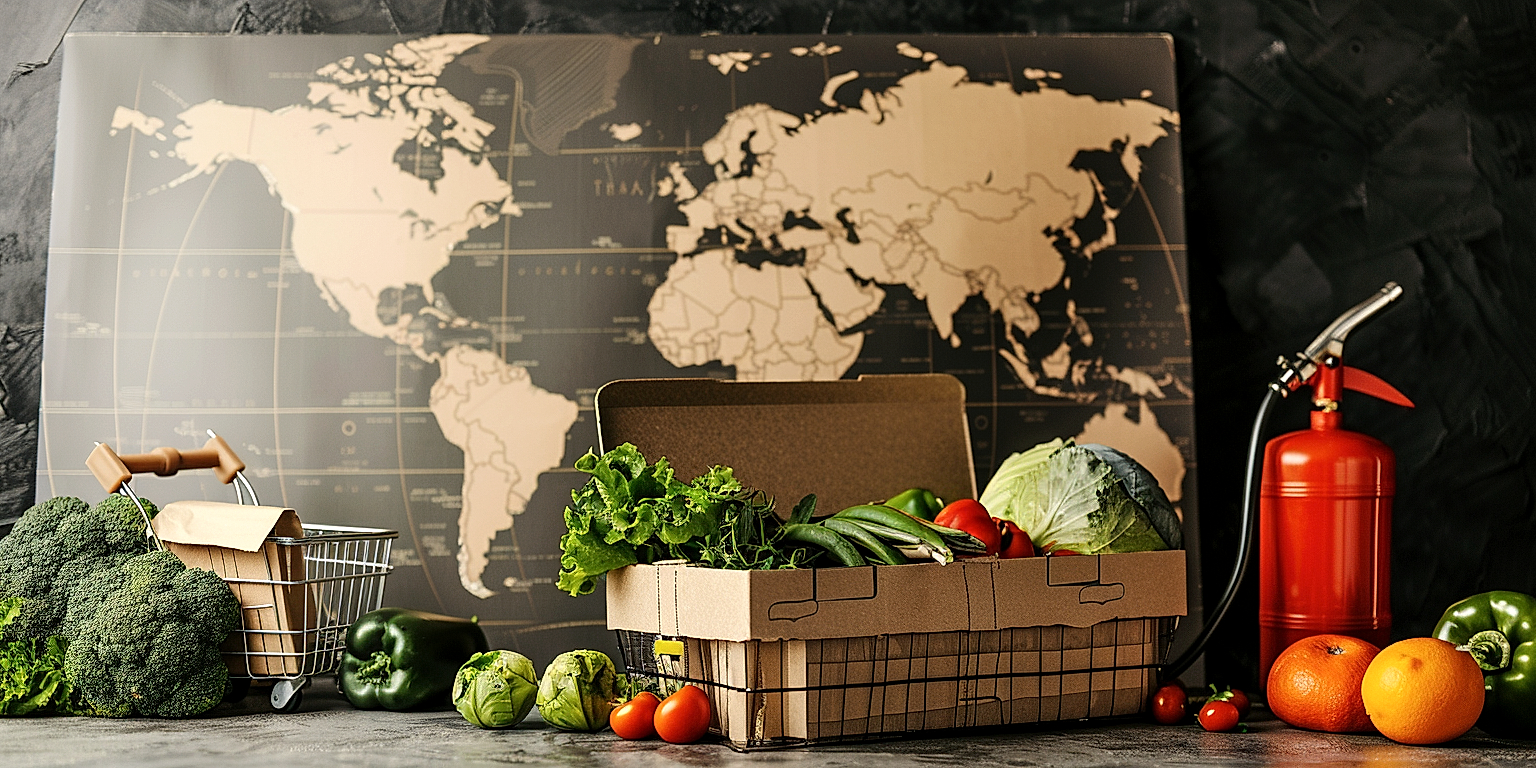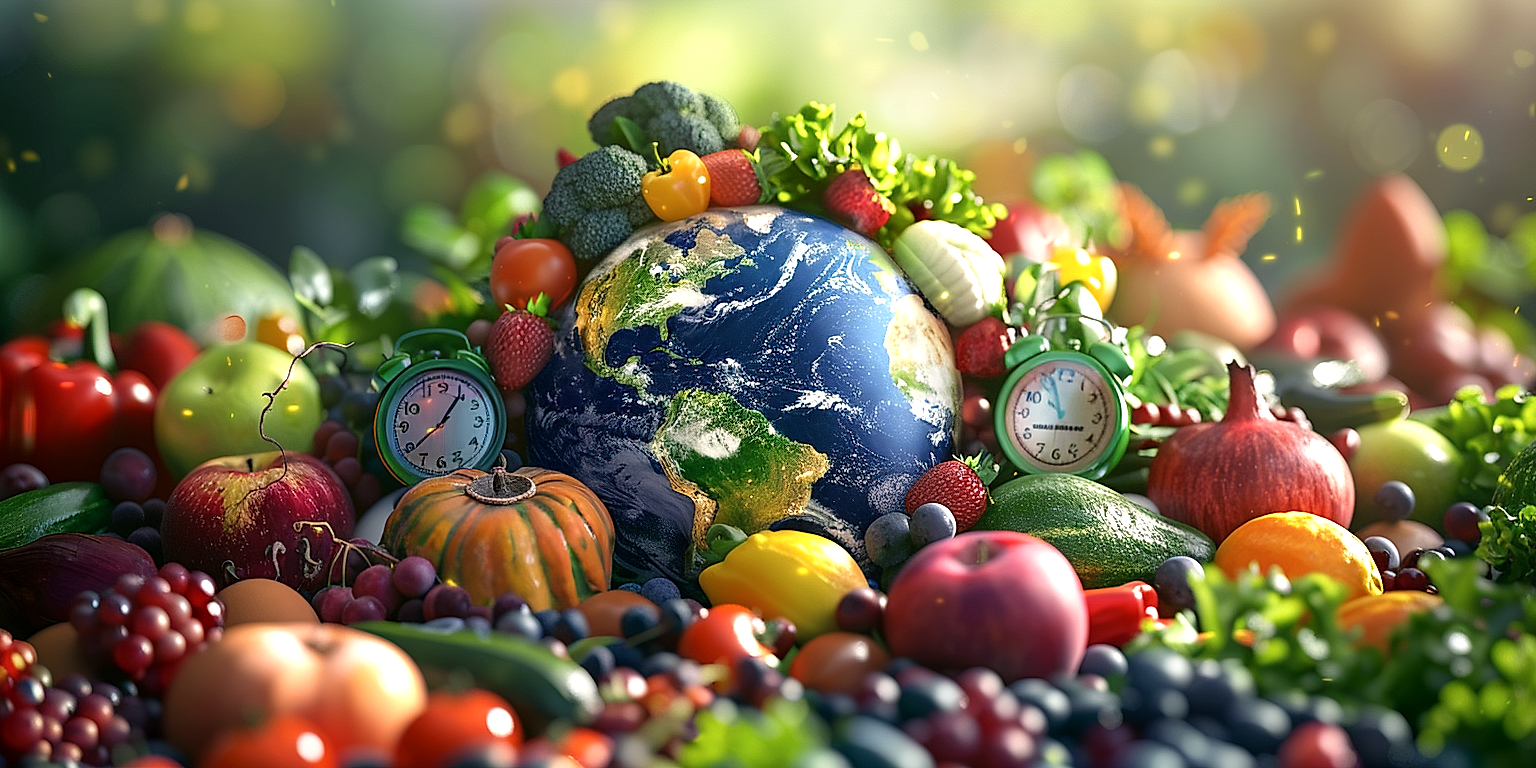The global supply chain has undergone a significant transformation over the years, affecting every sector, including agriculture.
Change has become the new normal, with cutting-edge technology revolutionizing various aspects of the industry.
With every transformation, transportation, particularly of fresh produce, is continuously evolving in a bid to adapt.
The focus is often on enhancing efficiency, reducing costs, ensuring sustainability, and minimizing waste.
Perhaps, even more importantly, these changes aim to guarantee the safe and timely transitions from farm to tables.
This article seeks to decode the recent advancements fostering these improvements, laying out the scope of their impact on produce shipping.
Contents
- Innovations Driving Change In Produce Shipping
- 1. Autonomous vehicle technology for long-distance transport
- 2. Real-time Tracking and Monitoring of Shipments
- 3. Advanced cold chain management systems.
- 4. Use of blockchain technology for supply chains.
- 5. Sustainable Packaging Materials for Longer Freshness
- 6. Predictive analytics for efficient route planning
- 7. Drones for Faster and Reliable Delivery
- 8. IoT Devices for Temperature and Humidity Control
- 9. AI-driven software for inventory management
- 10. Eco-friendly refrigerated shipping containers.
- The Bottom Line
Innovations Driving Change In Produce Shipping
1. Autonomous vehicle technology for long-distance transport
One of the biggest transformative technologies in the produce shipping industry is autonomous vehicle technology for long-haul deliveries.
This innovation enables the shipping process to be carried out more efficiently and with fewer risks associated with human error.
An autonomous vehicle, also known as a self-driving truck, contains advanced systems that can navigate the vehicle without human input.
These vehicles are equipped with intricate sensors, radars, and cameras that provide 360-degree situational awareness around the vehicle.
With the ability to operate for long hours without stops, autonomous vehicles can optimize shipping times and keep produce in better conditions for longer.
The adoption of autonomous vehicle technology also has the potential to reduce fuel consumption by maintaining optimized speeds and reducing unnecessary braking.
The integration of autonomous vehicle technology in produce shipping can have profound implications on the efficiency, cost-effectiveness, and environmental impact of the supply chain.
With autonomous vehicles, there’s a significant reduction in the dependency on human drivers who are subject to fatigue, thereby lowering the risk of road accidents.
It’s worth noting that the technology is still under constant development, with companies striving to ensure that it meets the highest safety standards.
Despite the challenges, numerous transport companies and technology firms are investing heavily in the development of this technology, hoping to revolutionize the logistics sector.
Autonomous vehicle technology also brings the prospect of streamlined operations and cost savings in the long run.
By reducing the need for human drivers, it could significantly cut labor costs, which make up a huge portion of shipping costs.
Moreover, autonomous vehicles are designed to operate at peak efficiency, which could drive down costs related to fuel consumption and vehicle maintenance, making the shipping of produce more affordable.
It’s also worth mentioning that autonomous vehicle technology, by virtue of its precision and predictability, can potentially improve planning and scheduling within produce supply chains.
This level of efficiency can have a ripple effect on the entire supply chain, including the retailers, which will experience improved reliability and can pass on the benefits to consumers in terms of fresher produce and lower costs.
Given these benefits, it’s clear that autonomous vehicle technology holds great promise as a catalyst for driving change in the produce shipping industry.
2. Real-time Tracking and Monitoring of Shipments
In the world of produce shipping, one significant innovation has been the introduction and advancement of real-time tracking and monitoring systems.
As the name suggests, these systems allow shipping companies to track and monitor their shipments in real-time.
This not only adds a layer of security to the shipping process, but also gives companies greater control over their supply chains, making them more efficient and productive.
Moreover, real-time tracking empowers companies with the ability to resolve issues as they come up, rather than after the fact, ensuring the produce reaches its destination in the best condition possible.
The development of this technology has been facilitated by the growth of the Internet of Things (IoT), which allows physical devices to connect to the internet and share data.
With real-time tracking, shipping companies can leverage IoT sensors that send real-time information about the location, temperature, humidity, and more, directly to a central monitoring system.
In the event of deviations from the predetermined limits, the system can alert managers so that they can take immediate corrective action.
This proactive approach to produce management reduces the risk of loss due to spoilage, damage, or theft, increasing overall operational efficiency and customer satisfaction.
Another advantage of real-time monitoring is it allows companies to offer their customers full visibility into the whereabouts of their goods.
Knowing the exact location and status of their produce gives customers peace of mind, knowing their shipment is being handled properly and is on track to arrive on schedule.
This level of transparency not only improves the customer experience, it can also enhance a company’s reputation and lead to increased business.
Moreover, real-time tracking and monitoring systems allow for the collection and analysis of large amounts of data.
This data can be used to identify trends, improve routes and resolve bottlenecks, enhancing the efficiency of the entire supply chain.
Looking forward, real-time tracking is expected to become even more advanced, with the potential for AI driven predictions and alerts.
Despite the remarkable benefits, implementing such systems can be a significant investment in terms of both time and resources.
However, the long-term benefits – lower chances of loss and spoilage, improved operational efficiency, increased customer satisfaction, and enhanced competitive advantage – make it an investment worth making.
3. Advanced cold chain management systems.
Within the realm of produce shipping, one of the key technological advancements has been the development of advanced cold chain management systems.
These systems are specifically designed to maintain a consistent, low temperature from the point of harvest through to delivery.
This step is vital considering that temperature is crucial in preserving the freshness, texture, and nutritional value of the produce.
Unlike traditional methods, advanced cold chain management systems offer real-time tracking of the temperature and also provide alerts if the temperature deviates from the set parameters.
As a result, the risk of produce spoilage is greatly reduced, thereby leading to lesser food waste and higher efficiency in operations.
Additionally, these systems enable businesses to ensure they are in compliance with the ever-strict regulatory standards.
Advanced cold chain management systems are not only ensuring the freshness and quality of the produce but are also helping businesses adhere to regulatory standards, thus transforming the dynamics of produce shipping.
Equipping shipping units with sophisticated sensors and IoT devices forms the backbone of these systems.
These devices monitor the temperature continuously and transmit the data to a central repository where it can be accessed and analyzed in real-time.
Thus, businesses get a clear insight into mass flow and cooling dynamics, which helps them make timely interventions and changes as needed.
Advanced cold chain systems also leverage cutting-edge AI technology to predict and manage potential risks in the cold chain.
It applies predictive analytics and machine learning algorithms to the collected data, enabling a proactive approach to problem-solving instead of a reactive one.
The system alerts the concerned stakeholders even before a potential malfunctioning or equipment failure leading to preventive maintenance rather than expensive repairs or replacements.
Furthermore, an optimized cold chain reduces the dependency on chemical preservatives, promoting a shift towards a more organic and sustainable food lifestyle.
Lastly, when coupled with sustainable packaging solutions, these systems can further enhance the shelf-life and quality of produce easing the challenges of longer shipping distances in today’s globalized world.
4. Use of blockchain technology for supply chains.
The application of blockchain technology in supply chains is one of the most impactful innovations driving change in produce shipping.
This technology provides an efficient and transparent way of tracing goods from the production site right to the consumers’ hands.
Through distributed ledgers, every stage of the produce shipping process can be documented and validated, enhancing trust and reliability.
Blockchain can mitigate issues of fraud, counterfeiting, and unethical practices in the supply chain by rendering transactions immutable and transparent.
With the implementation of blockchain, every transaction, transfer and movement of goods can be fully traced, ensuring trust and authenticity in the produce shipping industry.
Operativizing blockchain in logistics and supply chain management also contributes to a reduction of administrative overheads, consequently increasing efficiency and reducing costs.
This technology can facilitate automated contractual agreements, known as smart contracts, between parties, hence nullifying the need for costly and time-consuming middlemen.
It provides an opportunity for shippers to create a more sustainable and efficient supply chain, where wastage is minimized and optimal routing facilitated.
Companies can leverage blockchain to streamline their operations, optimize delivery routes, and enhance the visibility of the supply chains.
As the records on blockchain are immutable, it brings about an added layer of security to the supply chain, reducing the chances of data tampering and theft.
Despite multiple benefits, the adoption of blockchain in the produce shipping sector does come with some challenges.
These may include integration issues with existing systems, a lack of understanding of the technology, and apprehensions regarding data privacy and security.
However, with continuous advancements in the field, these issues are being surmounted gradually, leading to a more widespread adoption of blockchain in produce shipping.
The usage of blockchain technology in the industry is still in its nascent stages, with numerous potentials yet to be thoroughly capitalized.
Nevertheless, with its manifold benefits of transparency, traceability, and trustworthiness, blockchain is poised to revolutionize the produce shipping sector significantly.
5. Sustainable Packaging Materials for Longer Freshness
In the shipping industry, particularly in produce shipping, sustainability is becoming a significant concern as people are growing more conscious about the environment and looking for ways to reduce carbon emissions and waste.
Sustainable packaging materials have emerged as a viable solution to maintain the freshness of produce for longer periods, reducing food waste and enhancing customer satisfaction.
These materials are designed to be environmentally friendly, using less energy in their production, requiring less fuel for transport, and generating lower emissions than conventional packaging materials.
Most sustainable packaging materials are made from renewable, recycled, or bio-based materials such as plant fibers, making them compostable or recyclable.
Advancements have also been made in developing active packaging technologies that extend the shelf life of fresh produce. These technologies include antimicrobial packaging, oxygen sensors, and ethylene absorbers.
Factors such as temperature, humidity, and light exposure can be mitigated using these advanced packaging solutions, reducing the chances of premature ripening or decay.
One of the leading examples of sustainable packaging is edible coatings, made from proteins or polysaccharides. These coatings create a barrier against moisture and gases, extending the produce’s shelf life.
Intelligent packaging is another innovation in this field. These packaging systems can monitor the freshness of the product and provide real-time information to consumers and retailers about its condition.
They utilize sensors and tags to track the temperature and humidity levels within the packaging, ensuring the optimal storage conditions are maintained throughout the shipment process.
Not only do sustainable packaging materials contribute to reducing environmental impact, but they also offer a competitive advantage by meeting consumer demands for sustainable products.
These packaging solutions also lower unnecessary costs associated with food wastage and procurement of resources, contributing to economical sustainability.
However, to achieve a seamless transition to sustainable packaging, industry-wide collaborations are crucial. Partnerships between manufacturers, suppliers, retailers, and consumers can help drive the requisite change towards more sustainable practices.
The education of consumers, as well as the incorporation of sustainable practices into business models, is necessary to ensure the long-term success of these packaging innovations.
With such advancements, the future looks remarkably promising for the adoption of sustainable packaging materials in the produce shipping industry. It represents an essential step in the industry’s transition towards a more sustainable and efficient future.
Thus, incorporating these innovative packaging solutions is a necessity, not an option, for companies aiming to stay competitive and ecologically responsible in today’s business landscape.
6. Predictive analytics for efficient route planning
The advent of predictive analytics in logistics and transportation sectors has opened up myriad possibilities for efficient route planning and delivery optimizations.
Predictive analytics leverages algorithms, data, and machine learning techniques to anticipate future outcomes based on historical data.
It empowers shipping companies to improve efficiency, reduce fuel consumption, and ensure timely delivery by optimizing route planning.
In the realm of produce shipping, its significance is magnified manifold as it enables transporters to adhere to the stringent timelines and ensure freshness of produce.
Most shipping organizations now harness advanced analytics to predict possible disruptions, estimate delivery times, and efficiently plan routes even for multi-stop journeys.
Predictive analytics becomes instrumental in pre-empting potential obstacles such as traffic congestions, road repairs, or adverse weather conditions, thereby enabling preemptive measures for timely delivery.
By evaluating historical data related to traffic patterns, weather conditions, and preferred delivery routes, predictive analytics can forecast the most efficient routes for transportation.
The precise real-time data facilitates instant re-routing in case of any unforeseen circumstances, minimizing the impact on delivery timelines.
This smart technology not only saves time but also reduces fuel consumption, which leads to reduced costs and lowered carbon emissions, contributing to sustainable practices.
Moreover, when coupled with other technological advances such as autonomous vehicles and drone technology, predictive analytics can redefine the landscape of produce shipping.
It is also noteworthy that while predictive analytics greatly assists in route planning, a certain level of human intervention and discernment is still required to fine-tune and validate these predictions.
Adopting predictive analytics for route planning is quickly becoming a necessity, rather than an option for companies involved in perishable produce shipping.
Overall, it offers a compelling toolset of data-driven insights, which when harnessed correctly, can bring about transformative changes in the way produce shipping companies perform their operations.
Consequently, predictive analytics is certainly emerging as one of the major innovations that is set to fuel a paradigm shift in the field of produce shipping.
Looking ahead, as predictive analytics continue to evolve, it is expected to play an even more significant role in making produce shipping more efficient, sustainable, and cost-effective.
7. Drones for Faster and Reliable Delivery
The advancement of drone technology has proposed a pivotal shift in the logistics and delivery industry, particularly in the shipping of produce.
By leveraging drones, farms, and agri-businesses can ensure faster and more reliable delivery of fresh produce, thereby enhancing customer satisfaction and improving their brand reputation.
Drones are autonomous, which translates into fewer human errors, reduced delivery times, and improved service reliability.
This technology is not only aiding in prompt delivery but is also crucial in reaching hard-to-access geographical regions where traditional delivery systems may falter or not reach at all.
Drones have emerged as an alternative delivery mechanism, ensuring goods reach final consumers efficiently and safely, defying geographical barriers.
Drones are also capable of delivering highly perishable items like fruits and vegetables, where time is of utmost importance to retain their freshness.
Moreover, they can be tracked in real-time, offering transparency to all the stakeholders involved in the supply chain.
The use of drones also results in lesser fuel consumption compared to traditional transport based delivery mechanisms such as trucks.
This leads to reduced carbon emissions, aligning with the global move towards sustainability.
Furthermore, drones can be employed around the clock, underlining their potential for increasing operational flexibility and business availability.
Drones are also capable of carrying out inventory checks and updating the stock records with precision, thus assisting in inventory management.
However, the adoption of drone technology for delivery is not without challenges; there are regulatory hurdles, safety and privacy issues, and technology concerns that need to be addressed.
Despite these challenges, the potential of drones in transforming the produce shipping landscape is incredible and cannot be overlooked.
So, while it’s too early to predict the full impact of drone technology on produce shipping, it’s clear that it brings a galore of potential benefits to both businesses and consumers.
Consequently, more and more companies are investing in drone technology, signaling a paradigm shift in produce shipping.
Overall, drones are just one facet of the rapidly evolving landscape of innovation in produce shipping but they offer an exciting glimpse into the future of fresh produce delivery.
8. IoT Devices for Temperature and Humidity Control
In the evolving world of produce shipping, the adoption of Internet of Things (IoT) devices for temperature and humidity control has been a game-changer.
IoT devices, enabled with sensors and internet connectivity, provide a real-time solution for monitoring and controlling the temperature and humidity conditions within shipping containers.
They automatically feed these critical data back to a centralized system, thereby keeping a constant vigil on the freshness and quality of perishable produce during shipment.
With billions of produce being shipped annually, the introduction of IoT devices has managed to revolutionize the industry by cutting down on food spoilage and waste.
Through these devices, shippers can now remotely tweak the temperature and humidity inside these containers, keeping the produce fresh for longer periods.
This ensures only the highest-quality food products reach the consumers, preserving their taste, appearance, and nutritional value.
IoT devices not only improve the quality of shipped produce but also bring about significant cost savings by reducing energy use and preventing spoilage-related financial losses.
IoT-enabled temperature and humidity control is a critical innovation that directly contributes to the sustainability goals in the industry.
It enables shippers to reduce their carbon footprint by minimizing energy usage and decreasing waste from spoiled produce.
Another benefit of IoT devices is their ability to store and analyze data.
By constantly monitoring and recording temperature and humidity levels, these devices provide a wealth of information that can be analyzed to make strategic decisions about shipping and storage practices.
For example, patterns found in the data can help determine the best conditions for different types of produce, leading to tailored shipping practices for each fruit or vegetable.
There’s also a potential to integrate IoT devices with other new technologies, such as blockchain, for enhanced traceability and transparency in the supply chain.
Although there are challenges to overcome such as improved battery life and more reliable sensors, the potential benefits of IoT devices in produce shipping are enormous.
It is evident that IoT devices for temperature and humidity control are not just a passing trend but are set to become an essential part of the future of produce shipping.
Keeping pace with such innovations is crucial as technology continues to drive change in this industry, promising significant improvements in the quality and freshness of shipped produce.
9. AI-driven software for inventory management
One of the significant innovations driving change in the world of produce shipping is the use of AI-driven software for inventory management.
This innovation leverages the power of artificial intelligence to revolutionize the process of managing produce inventory, particularly in terms of accuracy and efficiency.
The use of AI in inventory management allows companies to predict patterns, automate tasks and make more informed decisions for their businesses.
One major benefit of this technology is that it significantly reduces the chances of human error, which can save businesses a lot of resources in terms of both time and money.
The software analyzes the sales data and can accurately forecast future sales trends, helping companies to manage their inventory effectively.
This capability also aids in addressing the issue of waste in the produce industry, by ensuring that businesses only order the quantities that they are likely to sell.
By combining AI with inventory management, businesses can efficiently handle their inventories, saving cost, reducing waste, and ultimately boosting their profitability.
Furthermore, these AI-driven systems are often equipped with real-time tracking capabilities which allows for on-the-go inventory updates, providing businesses with up-to-date knowledge about their stock levels.
Moreover, AI-driven inventory management systems have the capability to monitor stock levels and send alerts when reordering is necessary, thus eliminating the risk of running out of stock during crucial times.
This ability to predict demand and automate restocking makes AI-driven inventory management a game-changer in the produce shipping industry.
AI technology also has the potential to improve supply chain transparency by tracing produce from farm to fork, which is particularly important in today’s society where consumers are increasingly concerned with where their food is coming from.
The AI software systems can collect and analyze enormous amounts of data from various sources including suppliers, warehouses, and retailers to support better decision making at all levels of the supply chain.
AI-driven inventory management is not only changing the way businesses operate but also shaping the future of the entire produce shipping industry.
In addition to the above-mentioned benefits, the use of AI in inventory management could also lead to greater customer satisfaction as it allows businesses to meet customer demand more accurately and timely.
With the immense potential that AI offers, it has become a crucial part of the modern produce shipping industry, and its impact is expected to continue growing.
Indeed, AI-driven software for inventory management represents a significant innovation driving change in the produce shipping industry.
10. Eco-friendly refrigerated shipping containers.
Our exploration into the topic of Innovations Driving Change in Produce Shipping takes us to the development and use of eco-friendly refrigerated shipping containers.
These containers are a revolutionary innovation being employed to not only preserve the freshness of produce during long-haul deliveries but also minimize the environmental harm associated.
Eco-friendly refrigerated containers come equipped with advanced temperature control systems that maintain optimal freshness for different types of produce.
More to their efficiency, they utilize green energy sources, such as solar power, drastically reducing their reliance on fossil fuels.
This significant reduction in carbon emissions greatly bolsters these containers’ eco-efficiency, supporting the global movement toward more sustainable agricultural practices.
Beyond their environmental benefits, these containers come with considerable benefits for enterprises too.
They can, for instance, provide a competitive market advantage as they appeal to the growing number of consumers who prefer environmentally responsible brands.
Because they effectively preserve produce, these containers also reduce food wastage and the related losses for businesses.
Moreover, eco-friendly refrigerated shipping containers are a testament to technology’s power to transform, improve, and add value to the fresh produce sector.
The development and refinement of these containers incorporate aspects of smart technology, such as IoT for temperature and humidity control.
This integration of smart features augments precision, control and efficiency, demonstrating the multifaceted benefits of such innovation.
It’s worth noting that the eco-friendly refrigerated shipping containers’ deployment is not free of challenges.
These include high upfront costs, need for technical competency, and the uncertainty surrounding technology’s ongoing evolution and its implications.
Yet, many stakeholders in the fresh produce sector see these challenges as necessary hurdles, an investment in the future of both, the environment and the enterprise.
Looking at the broader picture, the rise of eco-friendly refrigerated containers illustrates how technological innovation can marry sustainability with practical business benefits in the produce shipping industry.
The Bottom Line
sentences long.
Advancements in technology are playing a pivotal role in revolutionizing the supply chain industry, bringing unprecedented efficiency, improved monitoring, and sustainability.
From autonomous vehicles to AI-driven software, the market is witnessing unparalleled advancements for long-distance transport, inventory management, and faster deliveries.
Innovations such as blockchain technology and predictive analytics are ensuring real-time tracking and smarter route planning.
Furthermore, the increasing use of eco-friendly materials and IoT devices embody the rising emphasis on sustainability and precision.
This blend of technology and sustainability promises a more efficient, reliable, and eco-conscious future for the global supply chain industry.




